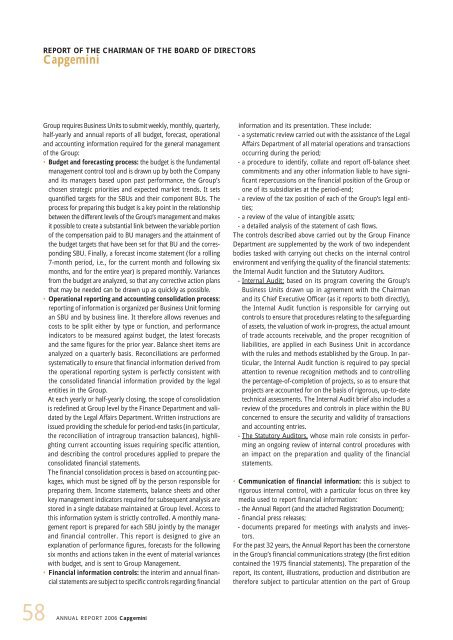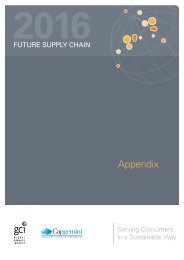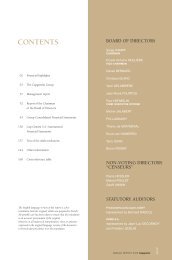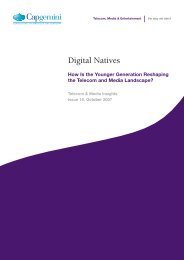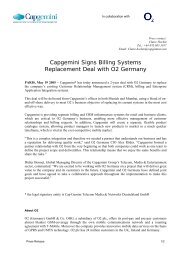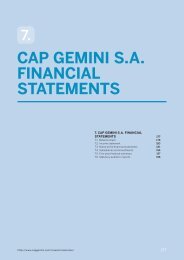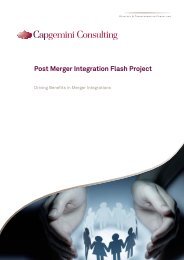Create successful ePaper yourself
Turn your PDF publications into a flip-book with our unique Google optimized e-Paper software.
58 ANNUAL<br />
REPORT OF THE CHAIRMAN OF THE BOARD OF DIRECTORS<br />
<strong>Capgemini</strong><br />
Group requires Business Units to submit weekly, monthly, quarterly,<br />
half-yearly and annual reports of all budget, forecast, operational<br />
and accounting information required for the general management<br />
of the Group:<br />
Budget and forecasting process: the budget is the fundamental<br />
management control tool and is drawn up by both the Company<br />
and its managers based upon past performance, the Group’s<br />
chosen strategic priorities and expected market trends. It sets<br />
quantified targets for the SBUs and their component BUs. The<br />
process for preparing this budget is a key point in the relationship<br />
between the different levels of the Group’s management and makes<br />
it possible to create a substantial link between the variable portion<br />
of the compensation paid to BU managers and the attainment of<br />
the budget targets that have been set for that BU and the corresponding<br />
SBU. Finally, a forecast income statement (for a rolling<br />
7-month period, i.e., for the current month and following six<br />
months, and for the entire year) is prepared monthly. Variances<br />
from the budget are analyzed, so that any corrective action plans<br />
that may be needed can be drawn up as quickly as possible.<br />
Operational reporting and accounting consolidation process:<br />
reporting of information is organized per Business Unit forming<br />
an SBU and by business line. It therefore allows revenues and<br />
costs to be split either by type or function, and performance<br />
indicators to be measured against budget, the latest forecasts<br />
and the same figures for the prior year. Balance sheet items are<br />
analyzed on a quarterly basis. Reconciliations are performed<br />
systematically to ensure that financial information derived from<br />
the operational reporting system is perfectly consistent with<br />
the consolidated financial information provided by the legal<br />
entities in the Group.<br />
At each yearly or half-yearly closing, the scope of consolidation<br />
is redefined at Group level by the Finance Department and validated<br />
by the Legal Affairs Department. Written instructions are<br />
issued providing the schedule for period-end tasks (in particular,<br />
the reconciliation of intragroup transaction balances), highlighting<br />
current accounting issues requiring specific attention,<br />
and describing the control procedures applied to prepare the<br />
consolidated financial statements.<br />
The financial consolidation process is based on accounting packages,<br />
which must be signed off by the person responsible for<br />
preparing them. Income statements, balance sheets and other<br />
key management indicators required for subsequent analysis are<br />
stored in a single database maintained at Group level. Access to<br />
this information system is strictly controlled. A monthly management<br />
report is prepared for each SBU jointly by the manager<br />
and financial controller. This report is designed to give an<br />
explanation of performance figures, forecasts for the following<br />
six months and actions taken in the event of material variances<br />
with budget, and is sent to Group Management.<br />
Financial information controls: the interim and annual financial<br />
statements are subject to specific controls regarding financial<br />
REPORT 2006 <strong>Capgemini</strong><br />
information and its presentation. These include:<br />
- a systematic review carried out with the assistance of the Legal<br />
Affairs Department of all material operations and transactions<br />
occurring during the period;<br />
- a procedure to identify, collate and report off-balance sheet<br />
commitments and any other information liable to have significant<br />
repercussions on the financial position of the Group or<br />
one of its subsidiaries at the period-end;<br />
- a review of the tax position of each of the Group’s legal entities;<br />
- a review of the value of intangible assets;<br />
- a detailed analysis of the statement of cash flows.<br />
The controls described above carried out by the Group Finance<br />
Department are supplemented by the work of two independent<br />
bodies tasked with carrying out checks on the internal control<br />
environment and verifying the quality of the financial statements:<br />
the Internal Audit function and the Statutory Auditors.<br />
- Internal Audit: based on its program covering the Group’s<br />
Business Units drawn up in agreement with the Chairman<br />
and its Chief Executive Officer (as it reports to both directly),<br />
the Internal Audit function is responsible for carrying out<br />
controls to ensure that procedures relating to the safeguarding<br />
of assets, the valuation of work in-progress, the actual amount<br />
of trade accounts receivable, and the proper recognition of<br />
liabilities, are applied in each Business Unit in accordance<br />
with the rules and methods established by the Group. In particular,<br />
the Internal Audit function is required to pay special<br />
attention to revenue recognition methods and to controlling<br />
the percentage-of-completion of projects, so as to ensure that<br />
projects are accounted for on the basis of rigorous, up-to-date<br />
technical assessments. The Internal Audit brief also includes a<br />
review of the procedures and controls in place within the BU<br />
concerned to ensure the security and validity of transactions<br />
and accounting entries.<br />
- The Statutory Auditors, whose main role consists in performing<br />
an ongoing review of internal control procedures with<br />
an impact on the preparation and quality of the financial<br />
statements.<br />
Communication of financial information: this is subject to<br />
rigorous internal control, with a particular focus on three key<br />
media used to report financial information:<br />
- the Annual Report (and the attached Registration Document);<br />
- financial press releases;<br />
- documents prepared for meetings with analysts and investors.<br />
For the past 32 years, the Annual Report has been the cornerstone<br />
in the Group’s financial communications strategy (the first edition<br />
contained the 1975 financial statements). The preparation of the<br />
report, its content, illustrations, production and distribution are<br />
therefore subject to particular attention on the part of Group


